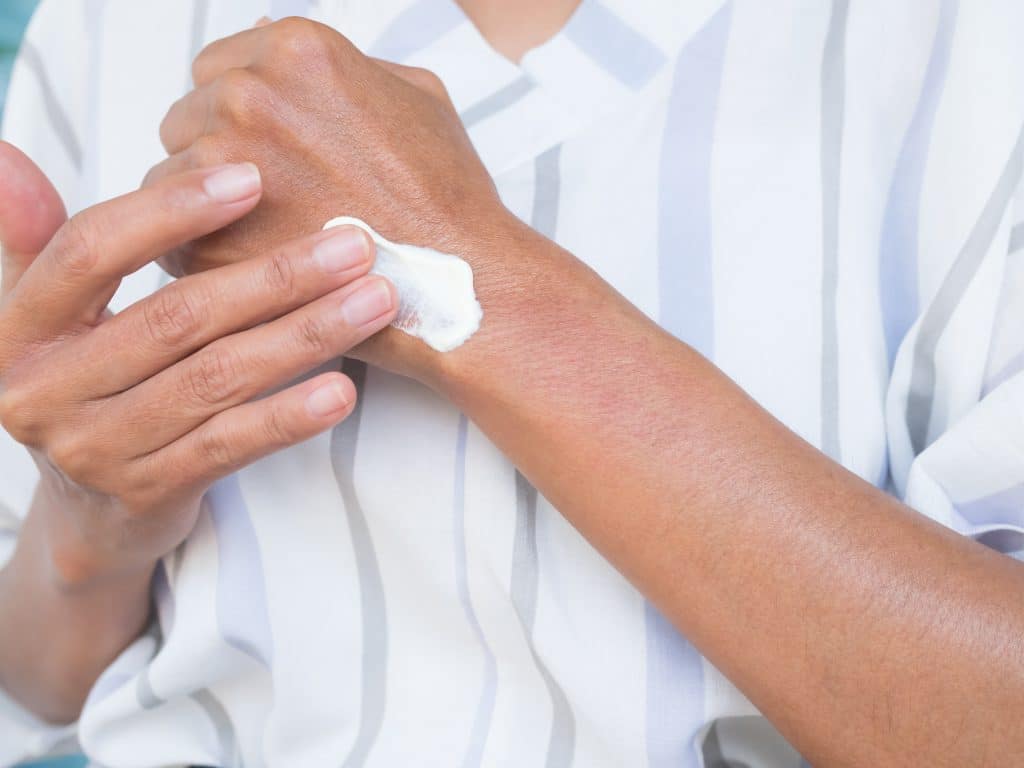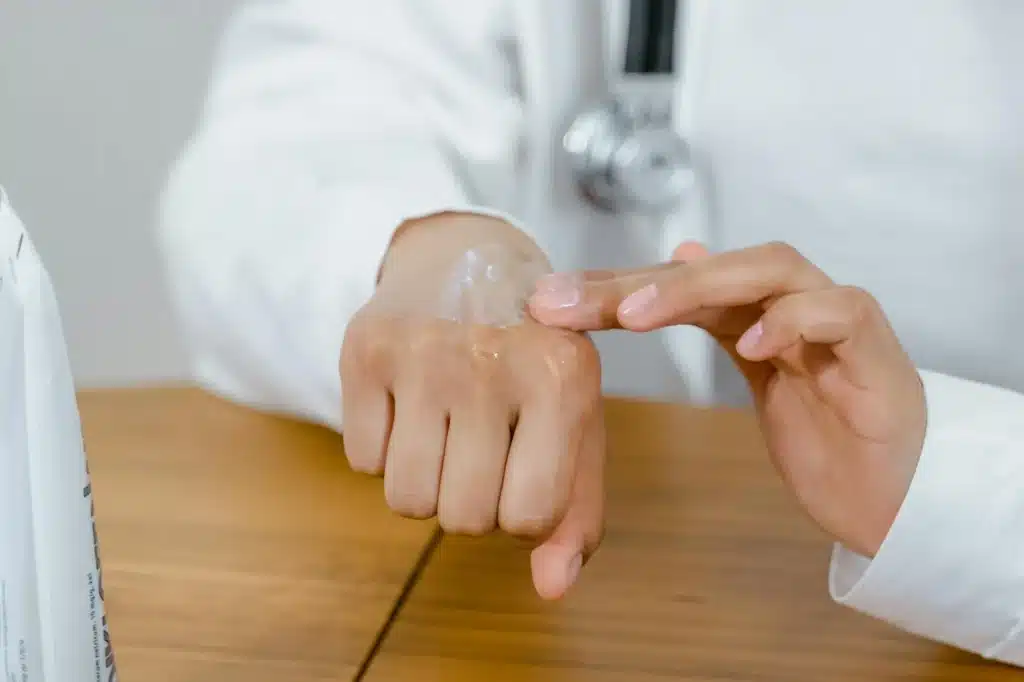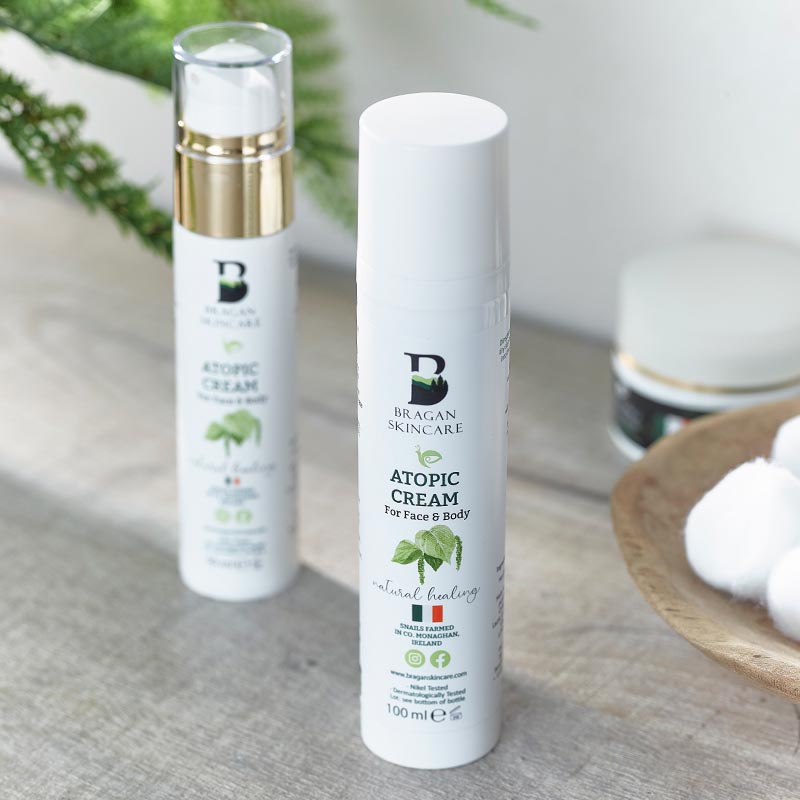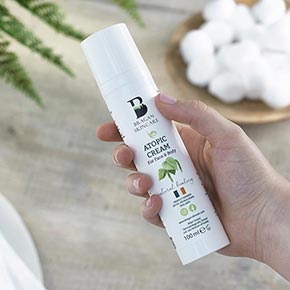Dyshidrotic Eczema: Causes, Symptoms, and Effective Treatments
Dyshidrotic eczema is a skin condition that causes itchy, blistering rashes, often on the hands and feet. For those affected, the symptoms can be frustrating, even painful, disrupting daily life. Understanding what triggers this condition and how to manage it is key to relief. Treatments can vary, but nature offers powerful solutions. Snail mucin, used for centuries to heal the skin, stands out as a unique ingredient. Packed with proteins, glycolic acid, and antioxidants, it soothes irritation, repairs damage, and deeply hydrates. Bragan Skincare’s Atopic Cream harnesses these benefits, offering a gentle yet effective option for managing flare-ups.

What is Dyshidrotic Eczema?
Dyshidrotic eczema is a recurring skin condition that typically affects the hands and feet. People dealing with it often experience intense itching and small, fluid-filled blisters, which can cause discomfort and disrupt daily routines. Understanding this condition is crucial for managing its symptoms and improving skin health.
Symptoms of Dyshidrotic Eczema
This condition presents through visible and physical signs that can escalate quickly if untreated. Here are some of the most common symptoms:
- Blisters: Tiny, itchy blisters usually appear on the sides of the fingers, palms of the hands, or soles of the feet.
- Itchiness: The itching is often intense and can worsen at night.
- Redness and Inflammation: The area around the blisters may become swollen and red.
- Scaling and Cracking: As the blisters heal, the skin may peel, crack, and become dry, which can leave it vulnerable to infection.
If you notice these signs, it is essential to take action promptly to reduce discomfort and irritation.

What Causes Dyshidrotic Eczema?
The exact causes are not fully understood, but several factors can increase the likelihood of developing this condition:
- Allergic Reactions: People with sensitivities to metals like nickel or cobalt might experience flare-ups.
- Stress: High levels of stress can trigger or worsen symptoms in some individuals.
- Seasonal Changes: Humidity and temperature shifts, especially in spring and summer, can aggravate symptoms.
- Skin Sensitivities: Contact with irritants such as detergents, soaps, or certain fabrics may lead to outbreaks.
While triggers vary by individual, recognising these patterns can help you avoid unnecessary suffering.
Why Snail Mucin Can Help With Dyshidrotic Eczema
Snail mucin has been used for centuries to treat various skin issues, and its value remains unmatched for eczema management. But what makes it so effective?
This natural ingredient is packed with components that soothe, repair, and protect the skin:
- Proteins: Promote cell repair and encourage the development of healthy skin tissue.
- Glycolic Acid: Gently exfoliates and helps improve texture, reducing irritation and dryness.
- Hyaluronic Acid: Delivers deep hydration, essential for relieving the dry, cracked skin caused by eczema.
- Antioxidants: Combat inflammation and support the skin’s natural healing process.
The Atopic Cream from Bragan Skincare capitalises on the power of snail mucin. Its unique formula can provide instant hydration while supporting long-term healing, making it a fantastic option for managing dyshidrotic eczema.
Causes of Dyshidrotic Eczema
Dyshidrotic eczema is a complex condition influenced by various factors. While the exact causes remain unclear, scientists have identified patterns that increase the likelihood of developing it. Stress, environmental impacts, and genetics often play significant roles, creating an ideal environment for flare-ups. Let’s break these down further.
Genetic Factors
Your genetic makeup can significantly influence your risk of developing dyshidrotic eczema. If you have a family history of eczema or other atopic conditions, such as asthma or hay fever, you may be predisposed. Research suggests that certain inherited traits affect the skin’s ability to retain moisture and protect against irritants.
When the skin barrier is weaker due to genetics, it becomes more vulnerable to allergens and irritants. This can spark inflammation and result in the itchy, blistering rashes typical of dyshidrotic eczema. Consider your skin as a barrier; genetically inherited cracks in this wall facilitate the penetration of external irritants. Knowing your family history can help you identify and manage potential risks earlier.

Environmental Triggers: : Dyshidrotic Eczema
External conditions often play a huge role in triggering dyshidrotic eczema flare-ups. Everyday environmental factors can irritate sensitive skin, leading to inflammation and itching. Some common triggers include:
- Exposure to metals: Nickel and cobalt, found in jewellery and tools, are known culprits.
- Chemical irritants: Harsh soaps, detergents, and cleaning products can strip the skin of its natural oils.
- Seasonal changes: Sudden shifts in weather, particularly during humid spring and summer months, can increase symptoms.
- Prolonged wetness: Constant exposure to water, sweat, or damp gloves may weaken the skin barrier.
If you notice symptoms flaring after using specific products or being in certain environments, consider adjusting your routines. Keeping a diary to track these triggers can be a helpful way to identify patterns and avoid repeated irritation.
Stress and Hormonal Changes
Stress doesn’t just affect your mind – it can wreak havoc on your skin too. When stressed, the body releases cortisol, a hormone that can weaken the immune system and trigger inflammation. Dyshidrotic eczema often worsens during high-stress periods, acting as a visual signal of inner tension.
Similarly, hormonal fluctuations, such as those during pregnancy, menstrual cycles, or menopause, can influence flare-ups. Your skin can react to these changes by becoming more sensitive, which raises the likelihood of developing blisters and irritation. Stress and hormonal shifts may appear imperceptible, but they have a profound impact on your skin.
To keep stress-related flare-ups at bay, relaxation techniques like deep breathing or scheduling time for self-care can be invaluable. Bragan Skincare’s Atopic Cream may also offer calming relief, especially when your skin needs soothing hydration during tough times.
By recognising the roles of genetics, environment, and stress, you can take steps to manage and prevent dyshidrotic eczema more effectively.
Symptoms of Dyshidrotic Eczema
Dyshidrotic eczema comes with a range of symptoms that can affect you both physically and emotionally. These symptoms often occur in cycles, with flare-ups followed by healing phases. Let’s take a deeper look at the most common ways this condition manifests.
Blisters and Rash
At the core of dyshidrotic eczema are its hallmark blisters. These are not your typical blisters caused by friction.
- They are small and often fluid-filled, appearing in clusters.
- Common areas include the palms of the hands, sides of the fingers, and the soles of the feet.
- The blisters may vary in size, with some being pin-sized while others grow slightly larger.
The skin around the affected area may appear red or inflamed. These blisters can pop, releasing fluid and causing the skin to crack or become sore. For many, these rashes are not just a visible issue; they can disrupt daily life with their irritating presence.

Itching and Discomfort
Living with dyshidrotic eczema can feel like a constant struggle against itching. This isn’t a mild, occasional itch – it’s intense and persistent.
- The itching often worsens at night, disrupting sleep and leaving you feeling drained.
- Scratching may bring temporary relief but can cause skin damage, leading to infection.
- Everyday activities, even something as simple as washing your hands or wearing shoes, can become uncomfortable.
Imagine trying to focus on work or relax at home while grappling with unrelenting itchiness – it’s enough to wear anyone down. The discomfort often leaves individuals searching for soothing solutions.
Dry Skin and Peeling
As the blisters heal, the skin enters a new stage of distress. This phase is marked by dryness and peeling, which can be as bothersome as the initial outbreak.
- Peeling skin reveals tender, new skin underneath, which is often fragile and prone to irritation.
- The area may feel tight, rough, or even develop cracks, making it painful to stretch or move.
- Without moisture, the skin becomes more vulnerable to developing further flare-ups or infections.
This dry, peeling period can linger for days or weeks, leaving the skin looking and feeling far from healthy. Hydrating and restoring the skin barrier becomes critical during this stage of recovery.
Understanding these symptoms can help create a plan to manage dyshidrotic eczema effectively. Recognising the signs early is one step closer to finding relief.
Treatment Options for Dyshidrotic Eczema
Dyshidrotic eczema can be a challenging condition to manage, but several effective treatment options exist. From soothing topical applications to lifestyle adjustments and emerging innovative products, understanding your options can help reduce flare-ups and discomfort.
Topical Treatments
Often, topical treatments serve as the primary treatment for dyshidrotic eczema. These creams and ointments work to reduce inflammation, itching, and dryness.
- Corticosteroid Creams: Prescription corticosteroids are commonly used to calm inflammation and relieve itching. They’re applied directly to the affected area.
- Calcineurin Inhibitors: Medicines like tacrolimus or pimecrolimus are non-steroidal options that help manage symptoms, particularly for long-term use.
- Moisturisers: Thick, fragrance-free emollients help lock in moisture, an essential step to prevent dry, cracked skin.
- Antibiotic Ointments: If blisters become infected, antibiotics may be applied to reduce bacterial growth and promote healing.
Consistency is key when using topical treatments, as they work best when incorporated into a daily skincare routine.

Lifestyle Changes
Small daily habits can help alleviate dyshidrotic eczema symptoms. Sometimes, simple lifestyle tweaks make a big difference in managing your skin’s health.
Here are ways to adjust your routine:
- Wear Gloves: Use protective gloves when handling cleaning products or immersing hands in water for extended periods.
- Avoid Irritants: Stay away from harsh soaps, detergents, and perfumes. Opt for gentle, fragrance-free alternatives.
- Hydrate the Skin: Apply moisturisers multiple times a day, especially after washing hands or bathing.
- Manage Stress: Practice stress-relief techniques, such as deep breathing or mindfulness, to minimise flare-ups.
- Stay Cool: Excessive sweating can irritate sensitive skin. Wear breathable fabrics and avoid tight shoes.
Adjusting your lifestyle might feel inconvenient, but over time, these changes can greatly reduce the frequency of flare-ups.
Alternative Treatments with Snail Mucin
For those exploring alternatives, snail mucin offers an intriguing and natural option. Used for centuries in skincare, snail mucin is packed with skin-repairing ingredients that make it suitable for soothing dyshidrotic eczema.
Bragan Skincare’s Atopic Cream stands out by harnessing snail mucin’s potent benefits. This ingredient provides a combination of:
- Glycolic Acid: Gently exfoliates and removes dead skin cells, revealing smoother, healthier skin beneath.
- Hyaluronic Acid: Deeply hydrates, soothing dry, itchy patches while promoting elasticity.
- Natural Proteins: Supports cell regeneration and speed up wound healing for damaged skin.
- Antioxidants: Fights inflammation, reducing redness and irritation commonly seen in dyshidrotic eczema.
What makes snail mucin unique? It works like nature’s first-aid kit. Each component addresses a specific aspect of eczema – from calming irritation to repairing the skin barrier.
Bragan Skincare’s Atopic Cream offers a modern way to integrate this age-old ingredient into your routine. Its gentle, fragrance-free formula ensures maximum benefits without irritating the skin further.
While traditional treatments target symptoms, snail mucin can work holistically, ensuring the skin not only recovers but also strengthens over time.
Benefits of Snail Mucin for Skin Health: Dyshidrotic Eczema
Snail mucin is becoming increasingly popular in skincare for a good reason. This natural ingredient offers incredible benefits for improving skin health, making it a promising treatment aid for conditions like dyshidrotic eczema. Let’s explore why snail mucin deserves its place in your routine.
Components of Snail Mucin
Snail mucin is packed with a powerhouse of beneficial ingredients that work hard to support skin health. Here are the key components:
- Glycoproteins: Essential for tissue repair, they strengthen the skin barrier and promote healing.
- Glycolic Acid: A natural exfoliant that gently removes dead skin, reducing rough patches and dullness.
- Hyaluronic Acid: Deeply hydrates by retaining water, giving the skin a plump and healthy appearance.
- Peptides: Stimulate collagen production, helping to improve elasticity and reduce scarring.
- Antioxidants: Protect the skin from environmental stressors and soothe inflammation.
Each element plays a role in restoring balance to your skin. For those with dyshidrotic eczema, this combination can reduce dryness, calm irritation, and repair damage.
Historical Use of Snail Mucin
The use of snail mucin for skincare isn’t a new trend; it has a long history. Ancient records show that the Greeks used crushed snails to reduce inflammation and heal wounds. In traditional medicine, farmers in Chile discovered that handling snails left their hands softer and smoother, sparking interest in its skincare applications.
Fast forward to today, and snail mucin is a sought-after ingredient in modern products. Time has proven its rich healing properties, demonstrating its reliability in treating a range of skin concerns, from acne scars to eczema.
Hydration and Repair
Severe dryness is one of the most troubling symptoms of dyshidrotic eczema. Snail mucin addresses this directly by providing intense hydration. Thanks to its high hyaluronic acid content, it locks in moisture, leaving the skin less prone to cracking or peeling.
In addition to hydration, snail mucin actively repairs damaged skin. The glycoproteins and glycolic acid work together to speed up cell renewal, encouraging faster healing of blisters and cuts. It’s like giving your skin a natural repair kit that also soothes redness and irritation.
This dual action of hydrating and repairing sets snail mucin apart not only as a moisturiser but also as a long-term solution for improving skin health. It strengthens the skin barrier, making it more resilient against future eczema flare-ups.
Bragan Skincare’s Atopic Cream incorporates snail mucin to deliver these benefits in an easy-to-use, gentle formula. By combining ancient wisdom with modern science, it helps you manage dyshidrotic eczema effectively without harsh ingredients.
Promoting Bragan Skincare’s Atopic Cream
When managing dyshidrotic eczema, finding the right product can feel overwhelming. Many treatments promise relief but fail to deliver. Bragan Skincare understands this challenge and has developed a solution. Their Atopic Cream, enriched with snail mucin, has become a trusted option for soothing and repairing sensitive skin. Let’s explore the experiences of users and where you can find this product to try it for yourself.
User Testimonials
Real stories from users highlight how Bragan Skincare’s Atopic Cream makes a difference. Here’s what they have to say:
- “I’ve tried countless creams, but Bragan’s Atopic Cream was the first to calm my dyshidrotic eczema within days.” – Alice, 34
- “The constant itching was unbearable until I discovered this cream. My skin hasn’t felt this good in years!” – Mark, 42
- “After weeks of cracked and peeling skin, my hands finally feel smooth and hydrated. I can’t recommend it enough.” – Sarah, 29
- “I was sceptical about snail mucin, but this cream truly works – no irritation, just relief.” James, 37
These testimonials show how this product provides relief for those struggling with the uncomfortable symptoms of dyshidrotic eczema.
Where to Buy Bragan Skincare Products
Interested in trying Bragan Skincare’s Atopic Cream? It’s easy to get your hands on their products.
You can purchase Bragan Skincare products directly from their official website, which ensures you receive genuine items and access to exclusive offers. Their online store also provides helpful information about the ingredients and benefits of each product.Shopping online eliminates the hassle of searching store to store. Simply order and have it delivered to your doorstep.
If you’re ready to tackle dyshidrotic eczema with a cream designed to heal and hydrate, look no further than Bragan Skincare’s Atopic Cream.
Conclusion: Dyshidrotic Eczema
Living with dyshidrotic eczema is challenging, but understanding the condition and taking proactive steps can make a real difference. Recognising triggers, seeking effective treatments, and adopting supportive skincare routines are key to managing symptoms and improving your quality of life.
Exploring natural remedies like snail mucin offers hope for those seeking gentle and proven solutions. With its powerful blend of hydration, repair, and anti-inflammatory properties, Bragan Skincare’s Atopic Cream provides a practical option for soothing flare-ups while supporting long-term skin health.
If you think you may have dyshidrotic eczema, consult a healthcare professional for tailored advice. Managing eczema might not be instant, but with informed choices, relief is within reach. Don’t let discomfort define your day—take steps towards healthier, happier skin today.
Don’t feel like you are on your own, check out some celebs that also suffer with the condition:
https://www.everydayhealth.com/eczema/celebrities-with-eczema/
Atopic Skin Repair Cream
Bragan Skincare Snail Mucin Atopic Cream At Bragan Skincare, we believe in doing things differently. Our Snail Mucin Atopic Cream isn’t just another product on the shelf—it’s a promise to your skin. Powered by the unmatched healing properties of pure snail mucin, this cream is specially crafted to soothe redness, calm irritation, and restore balance to even the most sensitive skin. Perfect for those suffering with Eczema, Psoriasis. Dermatitis and many other skin condition. Why snail mucin? Because it works. Packed with naturally occurring allantoin, glycolic acid, and peptides, it’s a game-changer for reducing redness, promoting repair, and deeply hydrating…
Featured Bragan Skincare Products
-
€39.99 – €100.00Price range: €39.99 through €100.00Select options This product has multiple variants. The options may be chosen on the product page
-
€100.00Select options This product has multiple variants. The options may be chosen on the product page


